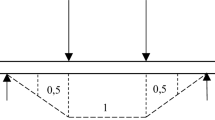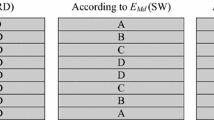Abstract
The work aimed at evaluating the influence of the veneer thickness on physical and mechanical properties of laminated veneer lumber (LVL) boards made from Schizolobium amazonicum plantation trees. It is a fast growing species (20 m3/ha/year), having a straight trunk almost without any branch and producing a white-yellowish low density hardwood: usually <0.40 g/cm3. The boards were manufactured with the following thicknesses: 1.54, 2.32 and 2.71 mm. Seven LVL boards were produced for each thickness, totaling 21, all according to the following characteristics: PVAc adhesive (200 g/m2), pressed (1.0 N/mm2) at room temperature for 12 h. The following mechanical and physical properties were then evaluated: static bending modulus of elasticity (E M ), modulus of rupture (f M ), compression strength parallel to grain (f c,0 ), shear strength parallel to glue-line (f v,0 ), shear strength perpendicular to glue-line (f v,90 ), water absorption and thickness swelling for 2 and 24 h of water immersion. The results pointed out that the utilization of thinner veneers implied improving mechanical properties, while thicker veneer reduced the water absorption. Nevertheless, in contrast, the efficiency was lower than that observed when thicker veneer was used.
Zusammenfassung
Ziel dieser Studie war es, den Einfluss der Furnierdicke auf die physikalischen und mechanischen Eigenschaften von Furnierschichtholz aus Schizolobium amazonicum Plantagenbäumen zu bestimmen. Hierbei handelt es sich um eine schnellwachsende Baumart (20 m3/ha/Jahr) mit geradem, fast astfreiem Stamm und weißgelbem Holz geringer Dichte, i.d.R. weniger als 0,40 g/cm3. Es wurden jeweils sieben Platten (insgesamt 21) in den Dicken 1,54 mm, 2,32 mm und 2,71 mm mit den folgenden Herstellparametern hergestellt: PVAc-Klebstoff (200 g/m2), Pressdruck (1,0 N/mm2), Presszeit von 12 Stunden bei Raumtemperatur. Bestimmt wurden die mechanischen und physikalischen Eigenschaften statischer Biege-Elastizitätsmodul (E M ), Biegefestigkeit (f M ), Druckfestigkeit in Faserrichtung (f c,0 ), Scherfestigkeit parallel (f v,0 ) und rechtwinklig (f v,90 ) zur Klebstofffuge, Wasseraufnahme (WA) und Dickenquellung (TS) nach 2- und 24-stündiger Wasserlagerung. Die Ergebnisse zeigten, dass die mechanischen Eigenschaften bei Verwendung dünnerer Furniere verbessert wurden, wohingegen bei Verwendung dickerer Furniere die Wasseraufnahme reduziert wurde. Insgesamt jedoch war die Verwendung dickerer Furniere effizienter als die von dünnen Furnieren.







Similar content being viewed by others
References
American Society for Testing and Materials—ASTM D 1037 (1999) Standard test methods of evaluating properties of wood-based fiber and particle panel materials
American Society for Testing and Materials—ASTM D 5456 (2006) Standard specification for evaluation of structural composite lumber products
Aydin I, Colak S, Çolakoğlu G, Salih E (2004) A comparative study on some physical and mechanical properties of laminated veneer lumber (LVL) produced from Beech (Fagus orientalis Lipsky) and Eucalyptus camaldulensis Dehn. veneers. Holz Roh Werkst 62:218–220
Bortoletto Júnior G (2008) Quality evaluation of Pinus merkusii wood for veneer production. (In Portuguese) Sci For 36:95–103
Burdurlu E, Kilic M, Ilce AC, Uzunkavak O (2007) The effects of ply organization and loading direction on bending strength and modulus of elasticity in laminated veneer lumber (LVL) obtained from beech (Fagus orientalis L) and lombardy poplar (Populus nigra L). Const Build Mater 21:1720–1725
Cristescu C (2006) Bonding of laminated veneers with heat and pressure only. In: (In Portuguese) II International Conference on Environmentally‐Compatible Forest Products, Proceedings, Porto, Portugal
Daoui A, Descamps C, Marchal R, Zerizer A (2011) Influence of veneer quality on beech LVL mechanical properties. Mad Cien Tecn 13:69–83
Iwakiri S, Matos JLM, Pinto JA, Viana LC, Souza MM (2010) Production of laminated veneer lumber LVL using veneer of Schizolobium amazonicum, Eucalyptus saligna and Pinus taeda. (in Portuguese). Cerne 16:557–563
Kamala BS, Kuman P, Rao RV, Sharman S (1999) Performance test of laminated veneer lumber (LVL) from rubber wood for different physical and mechanical properties. Holz Roh Werkst 57:114–116
Kelly MW (1977) A critical literature review of relationships between processing parameters and physical properties of particleboards. Forest Products Laboratory, Madison
Kiliç M (2011) The effects of the force loading direction on bending strength and modulus of elasticity in laminated veneer lumber (LVL). BioResources 6:2805–2817
Kilic Y, Colak N, Baysal E, Burdurlu E (2006) An investigation of some physical and mechanical properties of laminated veneer lumber manufactured from black alder (Alnus glutinosa) glued with polyvinyl acetate and polyurethane adhesives. For Prod J 56:56–59
Lara Palma HA, Ballarin AW (2011) Physical and mechanical properties of LVL panels made from Eucalyptus grandis. (in Portuguese). Ci Flo 21:559–566
Lee JN, Wu Q (2002) In-plane dimensional stability of three-layer oriented strandboard. Wood Fib Sci 34:77–95
Leicester RH, Bunker PC (1969) Fracture of butt joints in laminated pine. For Prod J 19:59–60
Lutz JF (1974) Techniques for peeling, slicing and drying veneer. Forest Products Laboratory, Madison
Marx CM, Moody RC (1982) Effects of lumber width and tension laminated quality on the bending strength of four ply laminated beams. For Prod J 32:45–52
Matos JLM (1997) Studies on the manufacture of Pinus taeda LVLs. (in Portuguese). Dissertation, PhD in Forest Science, Paraná Federal University
Müller MT (2009) The influence of different combinations of Eucalyptus saligna and Pinus taeda veneers in LVL structural panels. (in Portuguese). Thesis, Magister in Forest Engineering, Santa Maria Federal University
Pio NS (2002) Production of structural LVL from Eucalyptus grandis Hill ex Maiden (in Portuguese). Dissertation, PhD in Forest Science, Paraná Federal University
Schaffer EL, Jokerst RW, Moody RC, Peters CC, Tschernitz JL, Zahnj J (1972) Feasibility of producing a high-yield laminated structural product. Forest Products Laboratory, Madison
Siau JF (1971) Flow in wood. Syracuse University Press, Syracuse
Souza F, Del Menezzi CHS, Bortolleto Júnior G (2011) Material properties and nondestructive evaluation of laminated veneer lumber (LVL) made from Pinus oocarpa and Pinus kesiya. Eur J Wood Prod 69:183–192
Suchsland O (2004) The swelling and shrinking of wood. Forest Products Society, Madison
Wahab R, Samsi HW, Mohamed A, Sulaiman O (2008) Utilization potential of 30 year-old oil palm trunks laminated veneer lumbers for non-structural purposes. J Sustain Dev 3:109–113
Wu Q (1999) Application of Nelson’s sorption isotherm to wood composites and overlays. Wood Fib Sci 28:227–239
Youngquist JA, Laufenberg TL, Bryant BS (1984) End jointing of laminated veneer lumber for structural use. For Prod J 34:25–32
Author information
Authors and Affiliations
Corresponding author
Rights and permissions
About this article
Cite this article
de Melo, R.R., Del Menezzi, C.H.S. Influence of veneer thickness on the properties of LVL from Paricá (Schizolobium amazonicum) plantation trees. Eur. J. Wood Prod. 72, 191–198 (2014). https://doi.org/10.1007/s00107-013-0770-8
Received:
Published:
Issue Date:
DOI: https://doi.org/10.1007/s00107-013-0770-8




